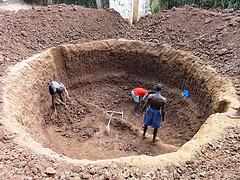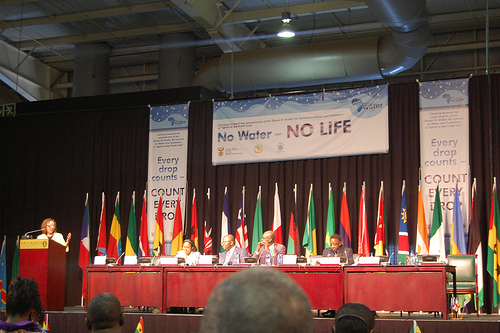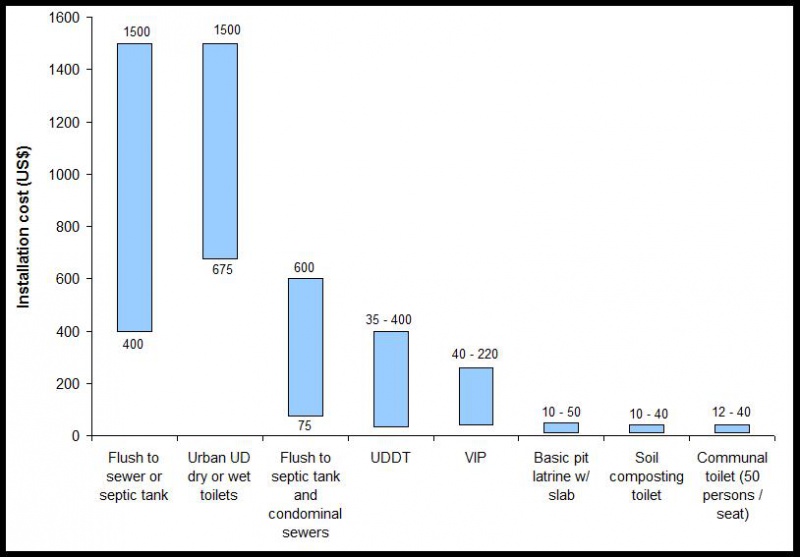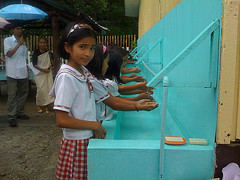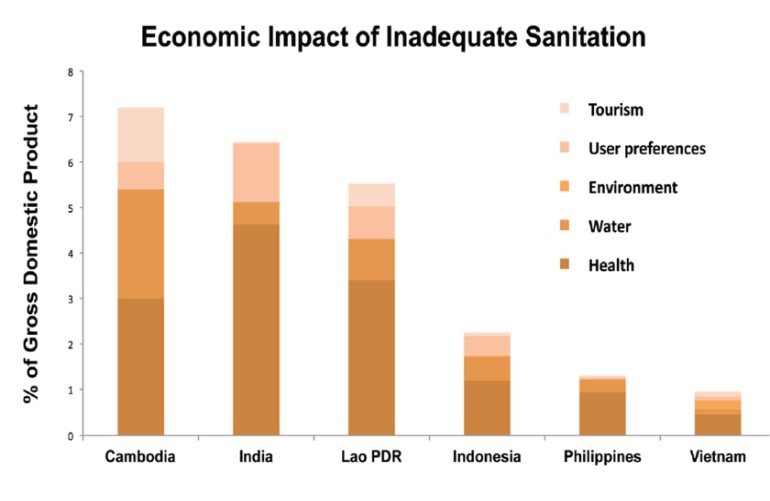Financial & Economic Costs & Benefits
Contents
1. Summary
Financial and economic analyses are a crucial part of feasibility studies assessing the benefits of improved sanitation and thus feed into policy decisions, sanitation programming and project design. The data generated by financial and economic analyses have major implications for the programming and design of sanitation projects, and are therefore crucial for the planning and delivery of affordable and sustainable sanitation services. In order to assess the relative sustainability of sanitation options, a range of comparative studies need to be conducted to show the real costs and benefits of moving from unimproved to improved and more sustainable sanitation options.A comparison of costs and benefits of different sanitation options using economic and financial analyses provides a justification for investments in sanitation in the first instance and enables decision makers to allocate limited resources more efficiently. Financial analyses only measure the costs and benefits that have direct and measurable financial implications, whereas economic analyses include all broader costs and benefits, including those that do not have financial implications.
For instance the costs for premature mortality are economic rather than financial. Capital expenditure (CAPEX), operational expenditure (OPEX) and capital maintenance expenditure (CapManEx) are the key parameters for both the financial and economic assessment of sanitation options. Important tools for financial and economic analysis include the cost-effectiveness ratio, Benefit-Cost Ratio (BCR), Net Present Value (NPV), or Internal Rate of Return (IRR). Key indicators for setting tariff structures and the assurance of affordability include:
- Full cost of sanitation per capita as a percentage of per capita GDP,
- Cost of access to sanitation as a percentage of household income
- Annual cost of sanitation as a percentage of household income
- Long run marginal cost and cost of sanitation services as a percentage of water tariffs. Economic analysis can also be used to assess the cost benefit of investments in sanitation in relation to other types of development interventions.
2. Background
Financial investment costs are often stated as one of the major barriers to increasing sanitation coverage – next to the lack of political will. Therefore, it is important to know what cash sum is affordable for the beneficiaries (households, communities, schools) and which share has to be financed either by the government, through grants (subsidies), loans from banks, or in-kind contributions (Mehta, 2005).Financial and economic analyses are key policy tools, which provide practical guidance on sanitation options, and can be used alongside other decision making frameworks such as multi-criteria analyses. Outputs of economic analysis can show the overall costs and benefits of improved sanitation compared to no or unimproved sanitation.
Financial and economic evaluation seek to provide further insight into the relative cost efficiency of different options as a basis for an informed choice. The inclusion of all feasible options is of key importance to the process of informing decision makers and planners of the potential range of sanitation options in a single context.
Hence, financial and economic analyses need to provide the decision maker with specific information that helps to judge the real costs and sustainability of different technologies. This means not just knowing the purchase price or capital costs but also operation and maintenance (O&M) costs, and the associated additional (direct or indirect) benefits to the user such as health, comfort and protection of the local environment.
An assessment of the benefits of improved sanitation may be applied to the following activities:
- Policy decisions- cost benefit analysis
- Sanitation programming
- Project design
Clearly, financial and economic evidence has value for a range of target groups – groups that have different roles and levels of influence in decisions on choice of sanitation technology or programme implementation:
- For policy makers
- For implementing agencies
- For the ultimate beneficiaries
3. Financial analysis: elements and indicators
Financial analysis focuses on expenditures and revenue streams and considers subsets of data that are identifiable as financial transactions. Financial assessment of sanitation options considers capital expenditure (CAPEX), operational expenditure (OPEX) and capital maintenance expenditure (CapManEx).To ensure sustainability, investors of sanitation systems such as utilities or local authorities need to consider:
- the recurring costs
- Revenues like service charges and from the sale of by-products
As shown in Figure 3, capital costs vary between different sanitation options, the project scale and even within one technology type CAPEX includes both hardware for household and shared toilet facilities as well as costs for waste collection, transport and treatment facilities. CAPEX also includes labour and management overheads for planning, construction and works supervision.
OPEX costs are those that are required to sustain the operation and maintenance of a system or facility. These include day to day costs such as labour, fuel, cleaning materials, and costs for repairs OPEX costs include for example pit or vault emptying, a fee for the treatment costs of faecal sludge and for software components.
Costs of “software” include sanitation promotion and demand creation (e.g. social marketing), awareness and educational campaigns to promote improved hygiene and system use, and capacity development of stakeholders, is essential for the uptake, compliance and long-term sustainability of all sanitation systems. These costs should be planned and fully budgeted for implementation of programmes on a larger scale; these costs should also be considered in the project design and in the OPEX.
CapManEx are costs that cover all expenditures to reduce the chances of asset failure and ensure the same level of service delivery as existed after construction. This includes the renewing, replacement, rehabilitation or refurbishing of broken system such as replacement of pumps.
The decision about which data to include in the financial analysis depends upon the boundary for the analysis which will be determined by the purpose of the analysis and the target group (see above).Given the range of sanitation stakeholders, there may exist different interpretations of the word “cost” and the forms of cost presentation. A disaggregation of household and third party costs is useful to be able to account for these different perspectives:
- Households - at the time of investment (e.g. connection fee, toilet investment) and during operation (e.g. wastewater levy, cost of sludge removal); and
- Third parties - in the form of investment subsidies or recurrent subsidies sourced from donor funds, state budget or cross subsidies such as from water tariffs.
From a household perspective, the main consideration is the expenditure related to sanitation facilities. Household expenditures or costs may be subsidised with external financing. Financial costs to households can be reduced by encouraging in-kind contributions from household members, and hence not only increasing participation but also reducing the requirement for cash funds.
The following indicators are relatively simple and can provide decision makers with information to support decisions about tariffs and affordability:
- Full cost of sanitation per capita as a percentage of per capita GDP (gross domestic product): To allow for a comparison between different projects or different options within one region.
- Cost of access to or annual cost of sanitation as a percentage of household income: If households are expected to make a significant up-front contribution without access to a credit mechanism, this single payment might constitute a serious barrier.
- Long run marginal costs (LRMC): The cost for one additional unit with the best resource allocation. It is calculated in relation to per capita and year to compare different regions with different household income.
- Cost of sanitation services as a percentage of water tariffs: decision makers often prefer the cost of sanitation related to water sales. This allows correlating full costs to current sanitation tariffs.
Table 1 of the original factsheet shows some examples for these cost indicators and illustrates considerable differences in the share of operation and maintenance costs as part of total costs. It also shows total costs of sanitation options as a percentage of gross domestic product (GDP) per capita, and household costs as percent of income for some examples.
4. Economic analysis: elements and indicators
Economic analysis includes the financial costing as the core of the analysis and additionally takes a broader perspective, encompassing social and environmental costs and benefits that can be ascribed with a monetary value. Therefore input data will include not only the financial cash flows but also in-kind or external costs and benefits. Economic benefits include those related to:- Health benefits such as avoided deaths and avoided morbidity;
- Economies of time saved seeking sanitation facilities or waiting to use these facilities as well as fewer sick days which results in greater productivity
- Environmental benefits such as reduced water pollution
- Reuse of human excreta - fertiliser, biogas etc.
- Wider benefits for the economy related to increased attractiveness for tourism and the business community.
Thus, economic analysis includes all costs and benefits of households – including the monetary value of in-kind contributions of materials and labour. Where reliable data are available, these economic benefits can be quantified and converted to monetary units to be included in full economic evaluation. A recent study by WSP found that eighteen African countries lose around USD 5.5 billion every year due to poor sanitation, with annual economic losses between 1% and 2.5% of GDP.
5. Economic benefits of resource-orientated sanitation
Different types of sanitation provide different levels of economic benefit in terms of mitigation of pollution impacts and environmental protection. Further financial or economic gains can be achieved with resource-oriented sanitation systems.Economic gains or cost savings which can be calculated:
- Excreta products which are produced and used on the person’s own property can be estimated by comparing the value of the included nutrients at the shadow prices for synthetic fertiliser
- Biogas for cooking can be valued at market prices of firewood or other locally used fuels for cooking.
- Water savings can be valued at the cost of provision of additional drinking water.
- Faeces converted to compost can be estimated by using the local price of compost
- Treated wastewater or greywater may be reused for irrigation or aquifer recharge. The market price for irrigation water from other sources can be used to value the benefit of reusing treated wastewater.
- Households who reuse their waste do not need to pay for pit emptying services or build a new pit when the old one is full.
Many of the argued (or predicted) benefits of reuse oriented sanitation are heavily related to context-specific programme conditions. For instance, the extent of the benefit will be closely related to the degree of community acceptance of excreta reuse, hygiene behaviour change and other factors that determine successful adoption of technologies.
6. Tools for financial and economic analysis
Whole life-cycle analysis involves a long term perspective which takes into account all costs incurred and benefits received over the total duration of the planned project which is known as the planning horizon. A concept similar to the accounting term of asset “depreciation” encourages long-term thinking and investment in technologies that are financially sustainable.
While providing the results of financial and economic analyses to potential users, following measures can be utilised:
- Cost-effectiveness ratio
- Benefit-Cost Ratio (BCR)
- Net Present Value (NPV)
- Internal Rate of Return
More information on each calculation method can be found in the factsheet.
7. Limitations of these analyses
Economic analysis requires the valuation of economic costs and benefits and is limited to the availability of reliable data. There is therefore a need for greater awareness of the analytical methods and indicators by researchers and practitioners and the application of standardised methodologies for data collection and analysis.
So far, little data exists to suggest the actual financial or economic value of fertilizer produced from, excreta. In the absence of in-depth research, a careful use of shadow prices is most appropriate to reflect the upper limit of economic value (i.e. equivalent fertiliser).
Available estimates of economic benefit of excreta reuse in the literature are challenging as they are largely based on hypothetical returns using expected excreta production, quality and prevailing market prices, as opposed to actual household economic impacts (Rockström et al., 2005; Oldenburg, 2007; Renwick, Subedi, Hutton, 2007).
Quantifying sanitation impacts and converting to monetary values to give accurate estimates of economic impact or benefit is a challenging task for various reasons:
- Firstly, improved sanitation is one of many ongoing development ‘interventions’ that affect socio-economic outcomes, such as health, education, agriculture and private sector development initiatives. Hence, robustly designed studies are needed which conduct data analyses adequately, accounting for a range of confounding variables.
- Secondly, the step of monetisation adds a further layer of uncertainty on the already uncertain physical/natural measurements of sanitation benefits. Prices can be highly variable, or markets may be imperfect thus distorting prices from the market equilibrium price level (which is the standard measure of welfare impact in economics).
- Additionally, prices may not exist at all, such as for some benefits of sanitation (e.g. comfort value, increased security for women or social impacts of improved sanitation) and thus need to be ascertained through proxy pricing or contingent valuation techniques. Hence, the analyst must compare the methods available, justify selection of a single method; and conduct sensitivity analysis to assess how uncertainty in price assumptions affects the overall benefit estimation.
8. Acknowledgements
SuSanA factsheet: Sanitation systems and technology options. April 2012, susana.org

